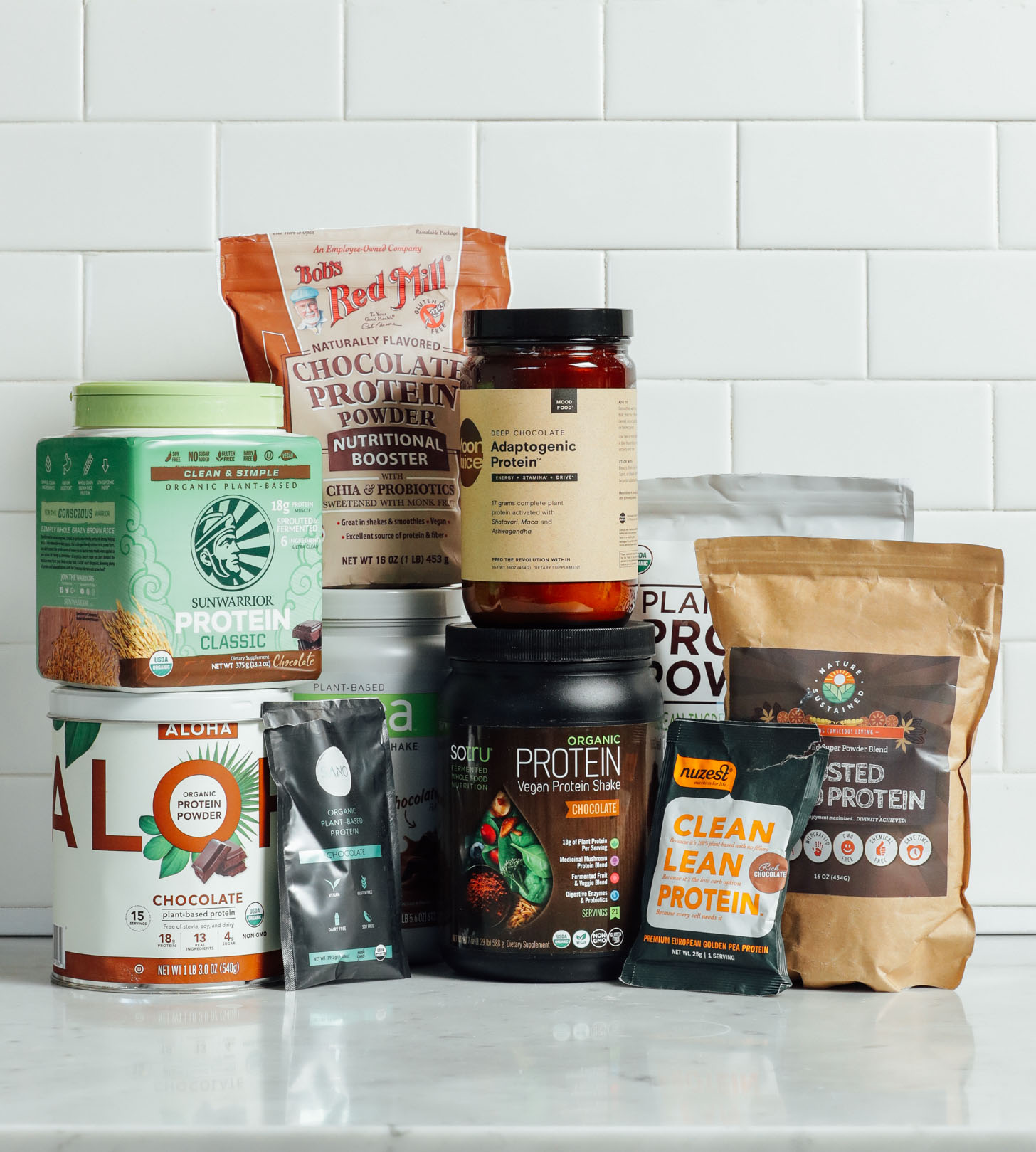
SO many of you enjoyed our Vegan Vanilla Protein Powder Review that we decided it was due time to put chocolate protein powders to the test!
As with the vanilla powders, we did a formal, side-by-side review of some of the most popular vegan protein powders on the market. We also added in some lesser known, innovative brands. Our goal was to see which protein powders delivered on taste and nutrition and which ones weren’t worth the hype, saving you the time and money of doing the research yourself!
THE GROUND RULES //
- We tested 10 protein powders and only ordered those we could find on Amazon because they are most accessible to people and usually have the best prices.
- This review is not sponsored in any way. We were not given free product or compensated for any of our reviews, and we had no contact with any of these brands.
- We excluded any products containing artificial colors or sweeteners, and did our best to include products with high-quality ingredients.
- We tried to be as unbiased and objective as possible when reviewing.
- When testing powders with non-dairy milk, we mixed 1/3 cup (80 ml) Forager Unsweetened Plain Coconut Cashewmilk with 1 Tbsp (15 g) protein powder in a mason jar with 2 ice cubes then shook vigorously for 30 seconds.
- When testing protein powders in smoothies, we blended 1/4 large frozen banana, 1/3 cup (80 ml) Forager Unsweetened Plain Coconut Cashewmilk, 2 ice cubes, and 1 Tbsp (15 g) protein powder. We blended for 45 seconds in a small blender.
- We graded the protein powders on a scale of 1-5 (1 being poor, 5 being excellent) on:
- Texture
- Sweetness
- Overall flavor
- How well it blended with non-dairy milk
- How well it tastes/blends with smoothies
- For consumer awareness, we also examined:
- Type of protein base (i.e. brown rice, pea, hemp)
- Grams of protein / serving
- Cost per serving (US $) – subject to variability
- Type of sweetener(s)
- Additives – potentially undesirable ingredients added to improve flavor, texture, etc.
- Quality of ingredients (i.e. organic, non-GMO, etc.)
- Additional perks (i.e. probiotics, greens, superfoods, quality salt)
- If we would repurchase
Results //
First place: Aloha Organic Chocolate Protein Powder
Second place: Nuzest Clean Lean Protein – Rich Chocolate
Third place: Bob’s Red Mill Chocolate Protein Powder
Fourth place: SoTru Organic Vegan Protein Shake – Chocolate
Fifth place: Nature Sustained Boosted Choco Protein (UPDATE: product has been discontinued by manufacturer)
Sixth place: Vega Essentials Shake – Chocolate
Seventh place: SANO Organic Plant-Based Protein – Chocolate
Eighth place: Sunwarrior Organic Classic Chocolate Protein
Ninth place: Pure Food Protein Powder – Raw Cacao
Tenth place: Moon Juice Deep Chocolate Adaptogenic Protein
Protein 101 //
Why is protein important?
Protein is a component of all of the cells in our bodies. It supports the production of enzymes, hormones, and so much more to keep us feeling good!
How much protein do we need?
The Institute of Medicine has recommended that adults consume 0.80 grams of protein daily per kg of body weight. For example, it’s recommended that an adult weighing 150 pounds (68 kg) consume ~54 grams of protein per day.
The protein powders tested in this review contain between 17 and 20 grams of protein per serving.
Why protein powders?
Chances are, if you are eating a nutritionally balanced diet, you are probably consuming enough protein.
However, for some (such as those following a vegan or vegetarian diet), it may require a little extra attention to ensure adequate protein intake is achieved. Not to mention, sometimes you’re just too busy for cooking — that’s when protein powders come in extra handy.
Though we prefer to have most of our meals closer to their “from the farm” roots, we find protein powders to be a great option when traveling, on-the-go, needing something simple, or when the fridge is low!
The Review //
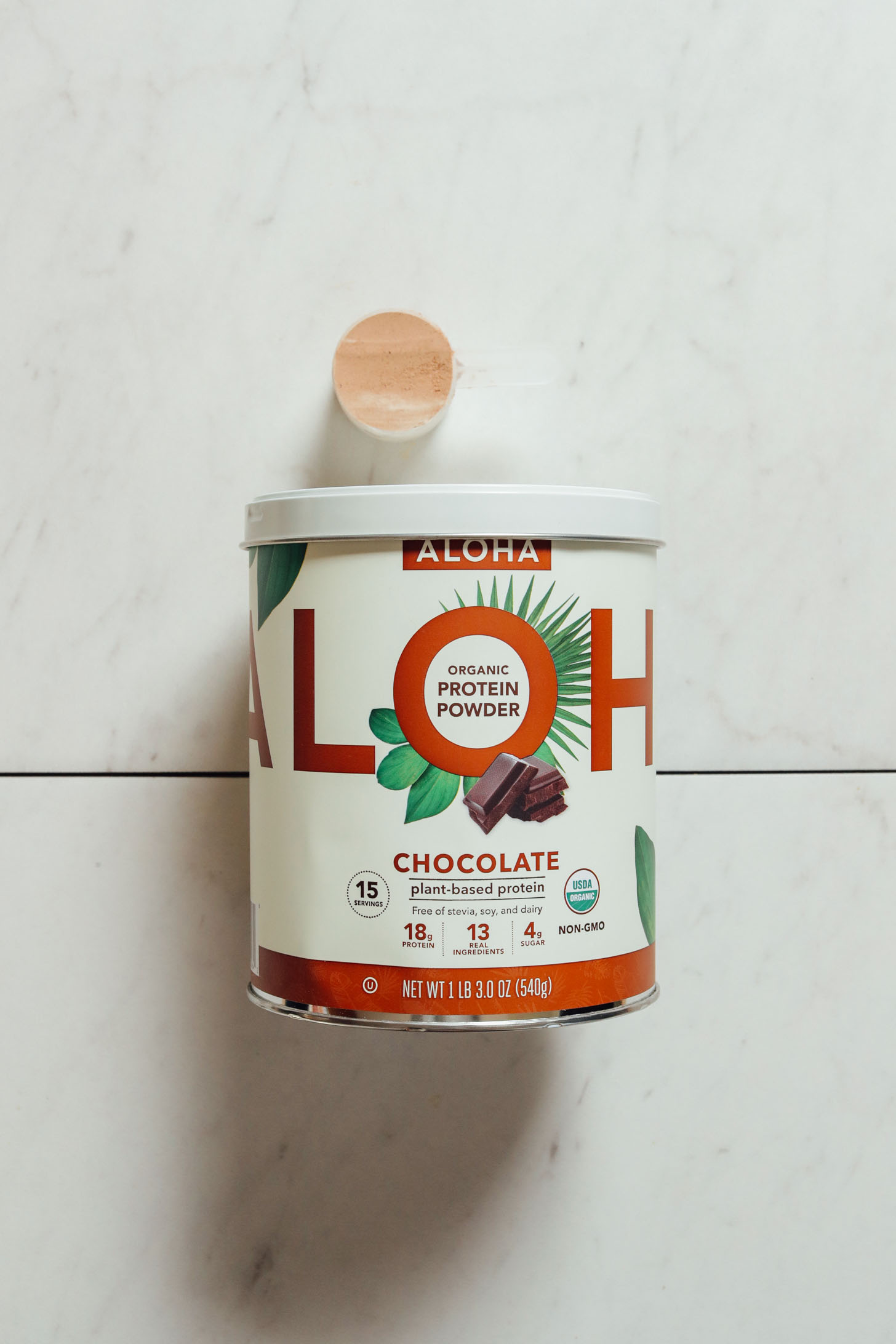
#1: Aloha Organic Chocolate Protein Powder
Texture: 5 – smooth with a little chalkiness
Sweetness: 5 – apparent but not overwhelming
Overall flavor: 4.5 – pleasant chocolate flavor with a slightly artificial sweetness aftertaste
How well it blended with non-dairy milk: 5 – really well
How well it tastes/blends with smoothies: 4.5 – texture is good, but slightly too sweet when blended with banana
Protein base: Pea protein, Brown rice protein, Hemp seed protein, Pumpkin seed protein
Protein / serving: 18 g
Approximate cost per serving: $1.60
Type of sweetener(s): Coconut sugar, Monk fruit extract
Additives: Acacia fiber, Natural flavor, Xanthan gum
Quality of ingredients: Organic, Non-GMO
Other perks: MCT oil
Overall score: 24/25
Overall impressions: Overall really good, but the aftertaste was very mildly unpleasant. Reminded us of a SlimFast shake, though not necessarily in a bad way.
Would we repurchase? Yes
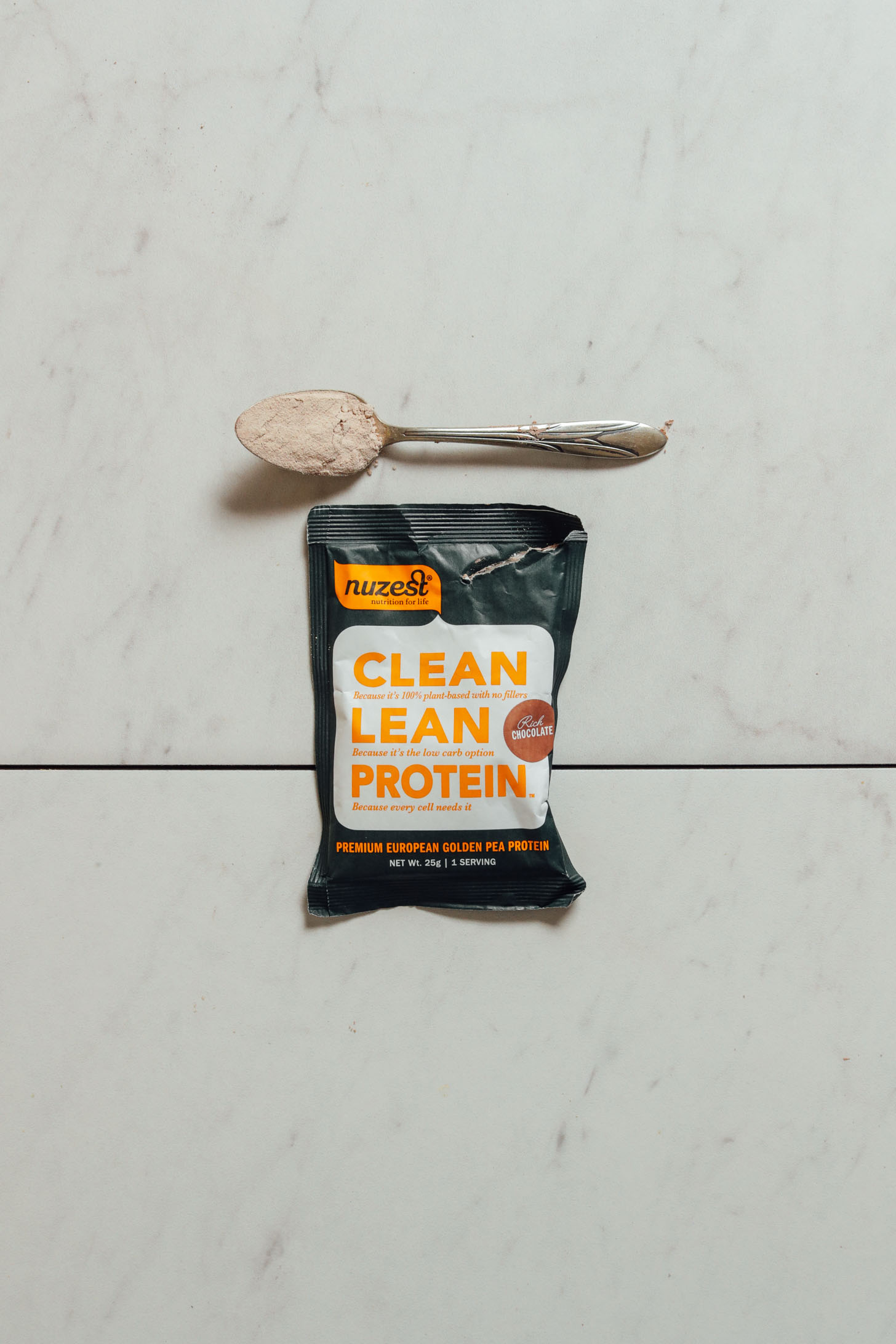
#2: Nuzest Clean Lean Protein – Rich Chocolate
Texture: 5 – very smooth
Sweetness: 3.5 – a bit much
Overall flavor: 4 – decent chocolate flavor, but with lingering over-sweetness
How well it blended with non-dairy milk: 5 – really well
How well it tastes/blends with smoothies: 4 – blends very smoothly, but definitely too sweet with banana and detectable artificial sweetness aftertaste
Protein base: Pea protein isolate
Protein / serving: 19 g
Approximate cost per serving: $2.14
Type of sweetener(s): Thaumatin (fruit-derived protein and sweetener)
Additives: Natural vanilla flavor, Natural chocolate flavor
Quality of ingredients: Non-GMO
Other perks: N/A
Overall score: 21.5/25
Overall impressions: Simple ingredients, really smooth, and not chalky, but tastes like it’s trying to be too healthy. We would like it better if the chocolate flavor was more prominent and there was less sweetness.
Would we repurchase? Yes
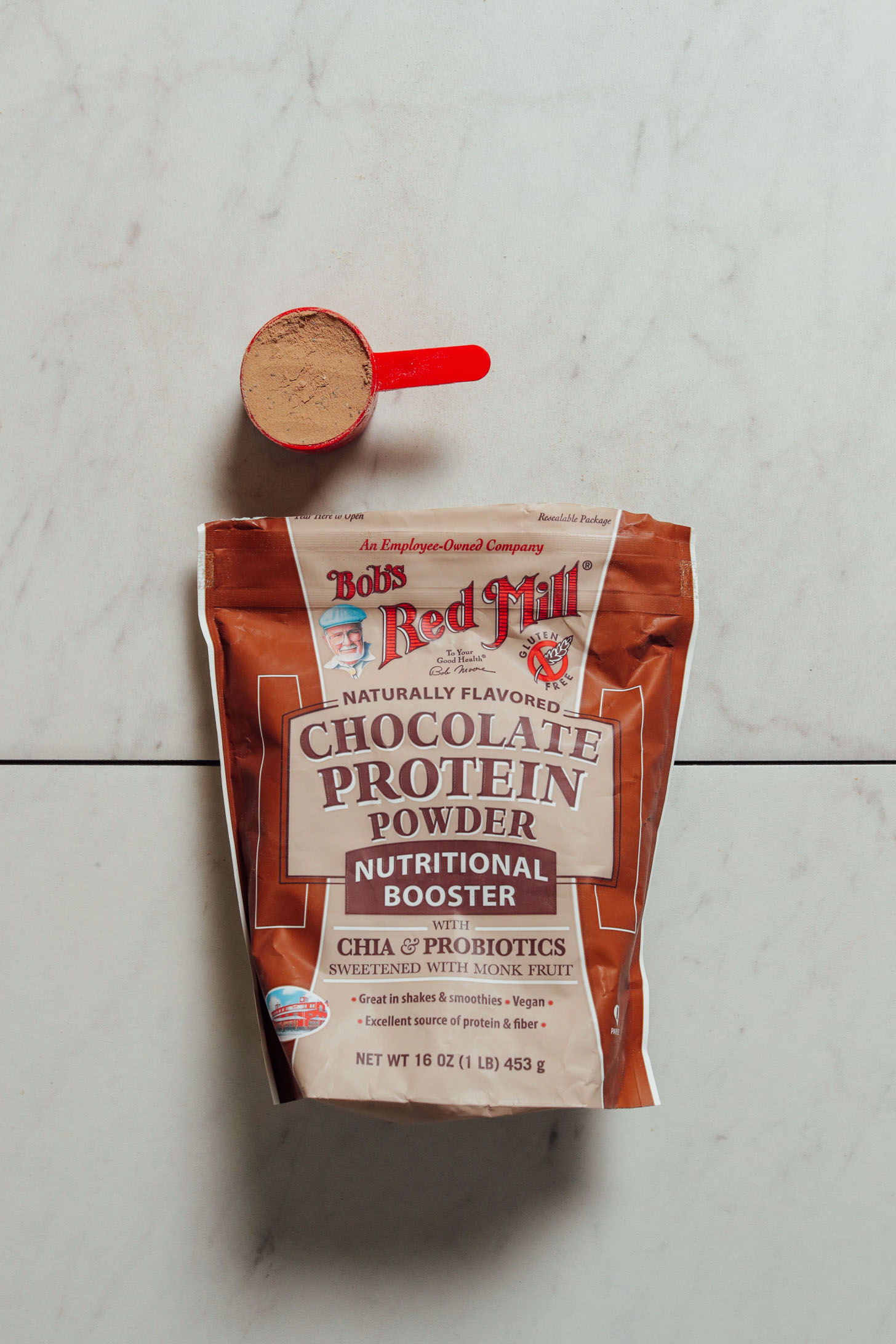
#3: Bob’s Red Mill Chocolate Protein Powder
Texture: 4.5 – creamy, only slightly chalky, visible chia seeds
Sweetness: 4.5 – mild, with a little room for improvement (doesn’t have that artificial sweetness flavor, though!)
Overall flavor: 4 – nice chocolate flavor, no bitterness or strange aftertaste, a little on the bland side
How well it blended with non-dairy milk: 4 – very good other than the chia seeds
How well it tastes/blends with smoothies: 4 – smooth and creamy; chia seeds mixed well. Not too sweet. Chocolate flavor is noticeable; wish it was a little stronger. We noticed a very slightly bitter aftertaste.
Protein base: Pea protein powder, Chia seed
Protein / serving: 20 g
Approximate cost per serving: $1.83
Type of sweetener(s): Cane sugar, Monk fruit extract
Additives: Chicory root fiber, Cornstarch, Organic inulin
Quality of ingredients: Non-organic
Other perks: Probiotic added (Bacillus coagulans)
Overall score: 21/25
Overall impressions: Overall good chocolate flavor and mild sweetness. We don’t love that it includes chicory root fiber and inulin, which can contribute to digestive upset for some people. Overall it wasn’t a love, but wasn’t a hate.
Would we repurchase? Yes (especially if it didn’t have chicory root fiber and inulin)
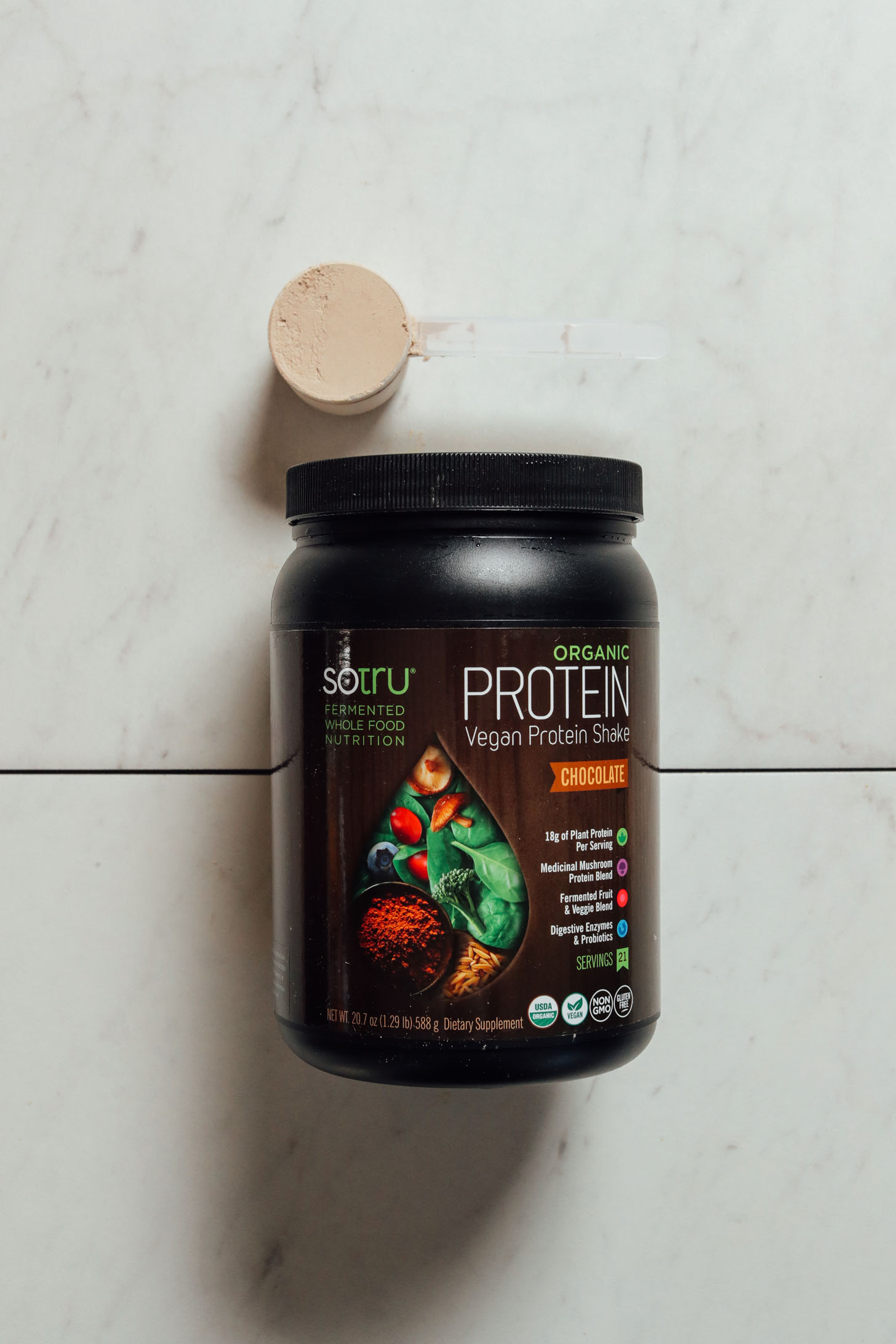
#4: SoTru Organic Vegan Protein Shake – Chocolate
Texture: 4 – a little grainy and powdery, but not chunky
Sweetness: 4.5 – slightly too sweet but not bad and no artificial sweetness detected
Overall flavor: 4 – detectable and very pleasant chocolate flavor with no bitterness or harsh aftertaste
How well it blended with non-dairy milk: 4 – a little powdery / grainy
How well it tastes/blends with smoothies: 3.5 – nice chocolate smell. A little too sweet. Initial taste is okay, but then it goes bitter. A little grainy when blended. Slight chemical taste.
Protein base: Brown rice protein, Quinoa, Amaranth, Mushroom blend (Reishi, King trumpet, Lion’s mane, Cordyceps, Himematsutake, Turkey Tail, Shiitake, Maitake), Chlorella, Spirulina
Protein / serving: 18 g
Approximate cost per serving: $1.95
Type of sweetener(s): Stevia leaf extract
Additives: Organic flavors, Xanthan gum
Quality of ingredients: Organic
Other perks: Fermented fruit & veggie blend, Probiotic added (Bacillus coagulans), Digestive enzymes
Overall score: 20/25
Overall impressions: Overall really enjoyable, pleasant flavors, not overwhelmingly sweet, and impressive ingredients. We only wish it mixed a little better.
Would we repurchase? Yes
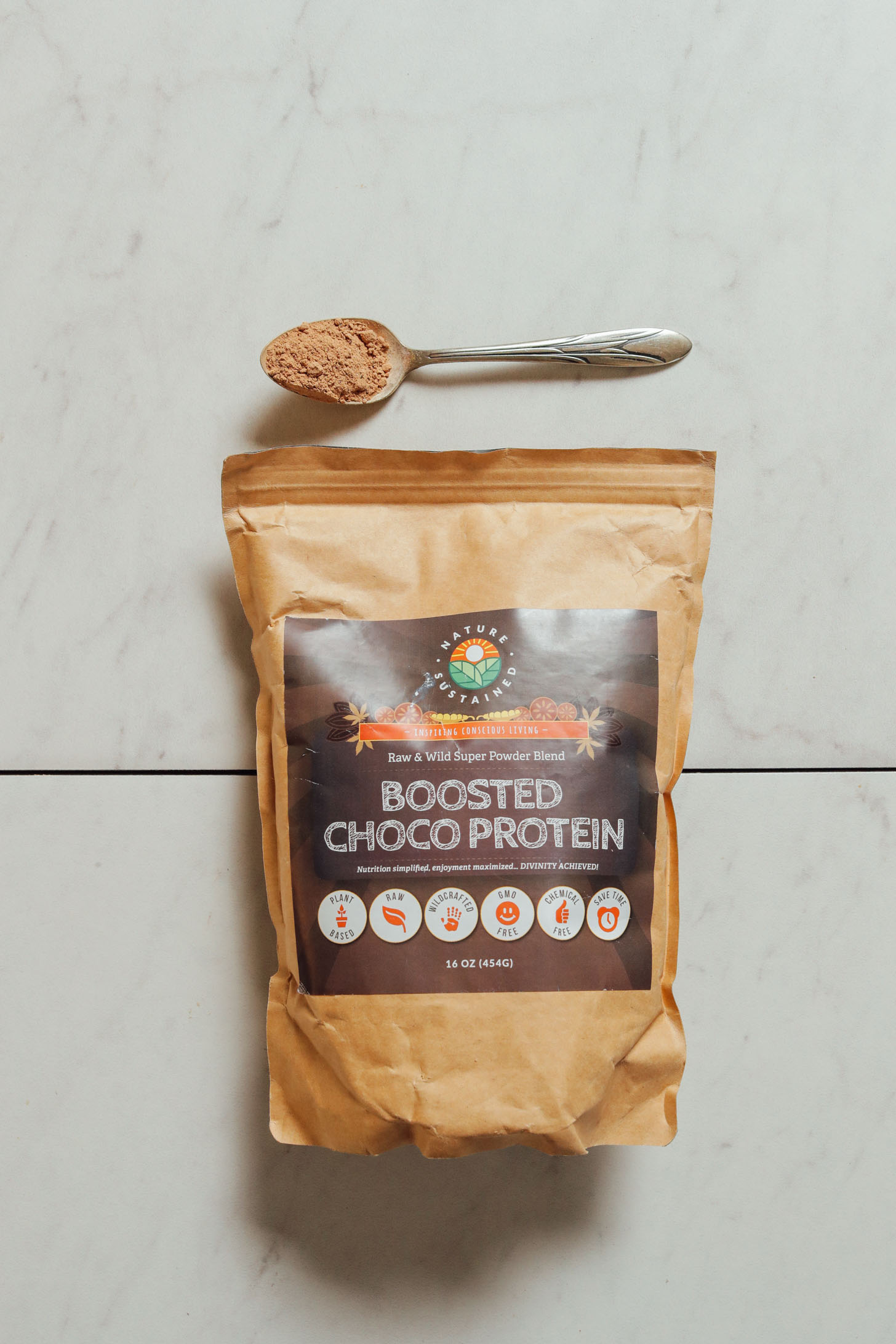
#5: Nature Sustained Boosted Choco Protein (UPDATE: product has been discontinued by manufacturer)
Texture: 4 – chunky (some chocolate, some chia) and slightly grainy
Sweetness: 4.5 – doesn’t taste artificial, not overwhelming, just right
Overall flavor: 4 – chocolate flavor is pleasant and detectable, but superfoods give a slightly unpleasant aftertaste. Mushroom powder slightly detectable.
How well it blended with non-dairy milk: 4 – a little grainy with visible chunks of chia and chocolate, and grainy residue at the bottom of glass
How well it tastes/blends with smoothies: 3.5 – smells good. Chocolate flavor is detectable but not very strong. Bitter. Pretty smooth. Not too sweet.
Protein base: Organic raw yellow pea protein powder, Organic raw brown rice protein powder, Organic raw hemp protein powder, Organic raw chia seed
Protein / serving: 18 g
Approximate cost per serving: $2.00
Type of sweetener(s): Luo Han Guo (monk fruit) flavor, Organic Stevia powder
Additives: None
Quality of ingredients: Organic, Raw, Wildcrafted
Other perks: Organic raw criollo arriba cacao powder, Organic camu camu berry powder, Organic raw maca root powder, Organic raw cordyceps mushroom powder, Organic raw acai berry powder, Himalayan sea salt, Organic vanilla bean (ground)
Overall score: 20/25
Overall impressions: Impressive considering clean ingredient profile and added superfoods. Not incredible tasting but it has a pleasant chocolate flavor and no bitterness or off-putting aftertaste. We wish the texture was smoother, but overall it is good.
Would we repurchase? Yes
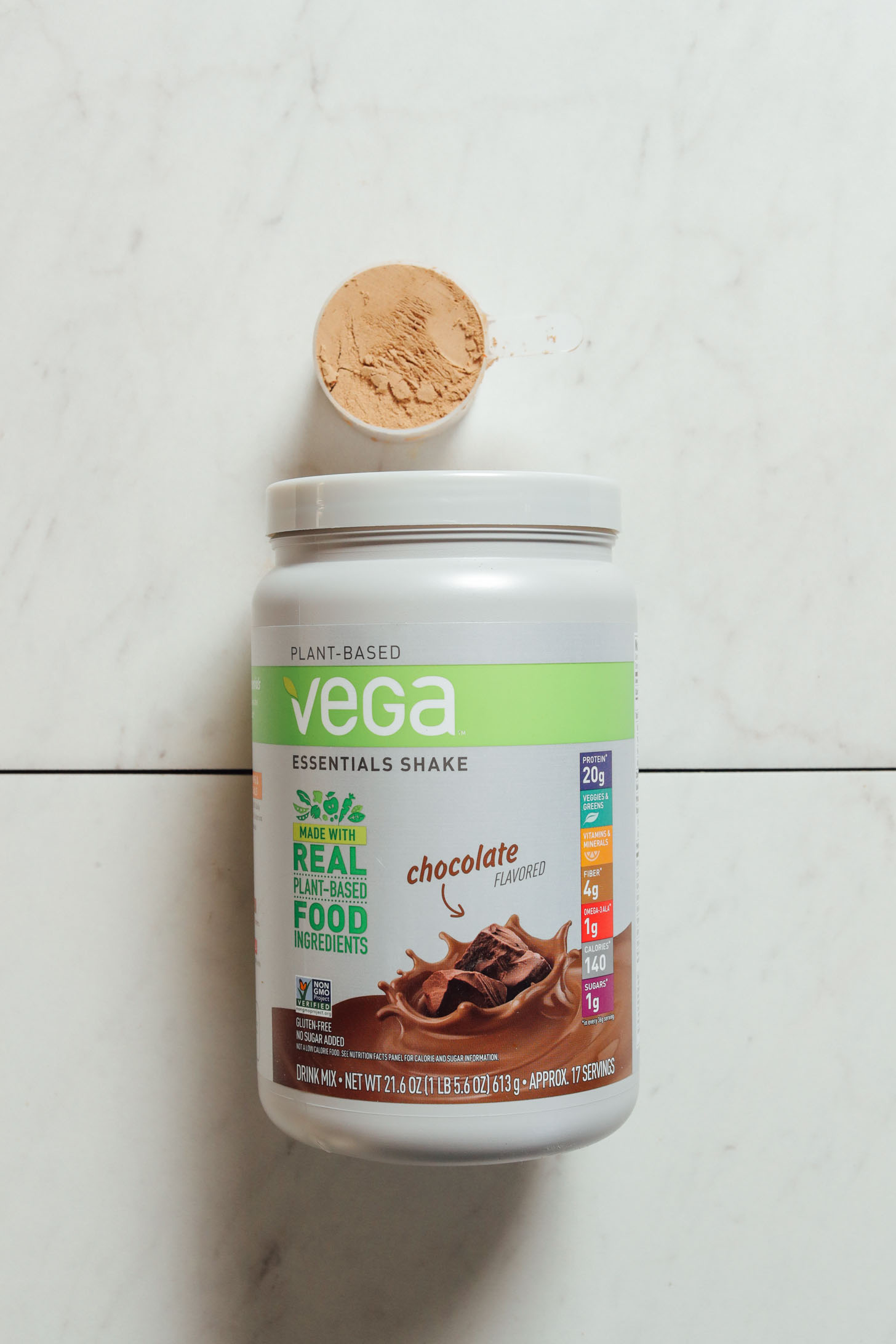
#6: Vega Essentials Shake – Chocolate
Texture: 4.5 – not creamy, but smooth and not chalky
Sweetness: 3.5 – not incredibly overwhelming, but artificial sweetness is very detectable
Overall flavor: 2.5 – chocolate flavor not prominent, algae and spirulina are mildly detectable, and leaves an overall unpleasant flavor on the palate
How well it blended with non-dairy milk: 5 – really well
How well it tastes/blends with smoothies: 2.5 – The smell is off-putting, too sweet, and has a chemical / medicinal flavor
Protein base: Pea protein, Flaxseed, Hemp protein
Protein / serving: 20 g
Approximate cost per serving: $1.65
Type of sweetener(s): Stevia leaf extract
Additives: Natural flavors, Organic acacia gum, Pea starch, Xanthan gum, Sunflower seed oil powder
Quality of ingredients: Non-GMO
Other perks: Marine algae, Organic spirulina, Acerola cherry extract, Bromelain (an enzyme), Fruit & vegetable blend, Mushroom powder
Overall score: 18/25
Overall impressions: Smells off-putting, but doesn’t taste quite as bad as it smells. The chocolate flavor is not very prominent, but the artificial sweetness is overwhelming. Overall, we disliked this one.
Would we repurchase? No
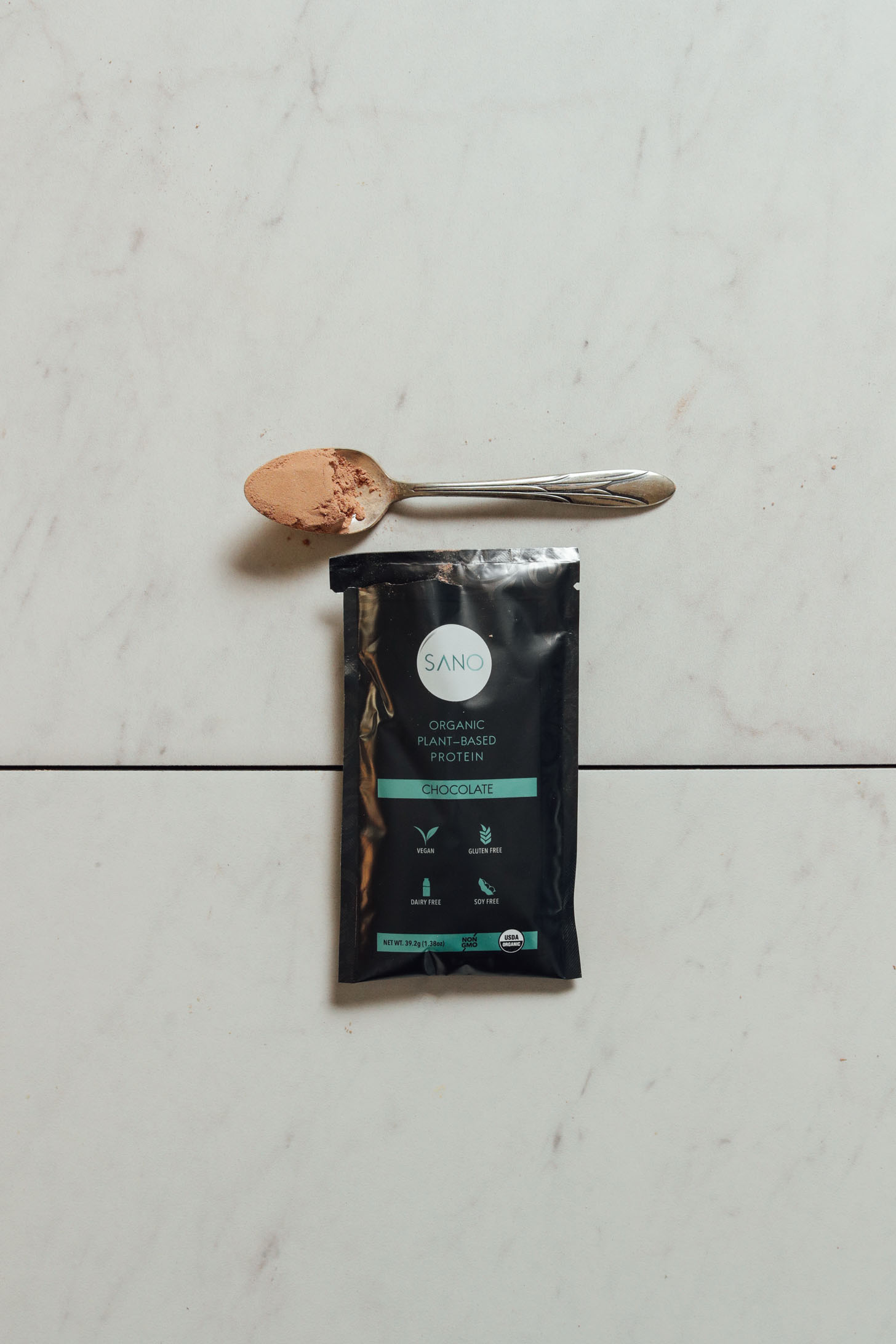
#7: SANO Organic Plant-Based Protein – Chocolate
Texture: 3 – a little grainy
Sweetness: 3.5 – not overwhelming. Level of sweetness is good, but flavor of sweet is not great.
Overall flavor: 2.5 – chocolate flavor tastes artificial, slight aftertaste, overall unpleasant
How well it blended with non-dairy milk: 3.5 – overall okay, but a little grainy
How well it tastes/blends with smoothies: 4.5 – Much improved when blended with banana. Pretty smooth texture. Takes on a slight caramel taste when blended. Not too sweet and no artificial sweetness / flavor detected. Tastes like a chocolate shake!
Protein base: Organic pea protein, Organic flax (seed), Organic hemp protein
Protein / serving: 20 g
Approximate cost per serving: $2.14
Type of sweetener(s): Organic Stevia (leaf)
Additives: Organic natural vanilla flavor, Organic guar gum
Quality of ingredients: Organic
Other perks: Organic lycium (goji berry), Organic cassia (cinnamon bark), Himalayan pink salt
Overall score: 17/25
Overall impressions: Initial taste is off-putting, but it gets better the more you drink it (though we still don’t consider it great). We wish the chocolate flavor was more prominent.
Would we repurchase? Yes (if blending with smoothie, but not for shaking with dairy-free milk)
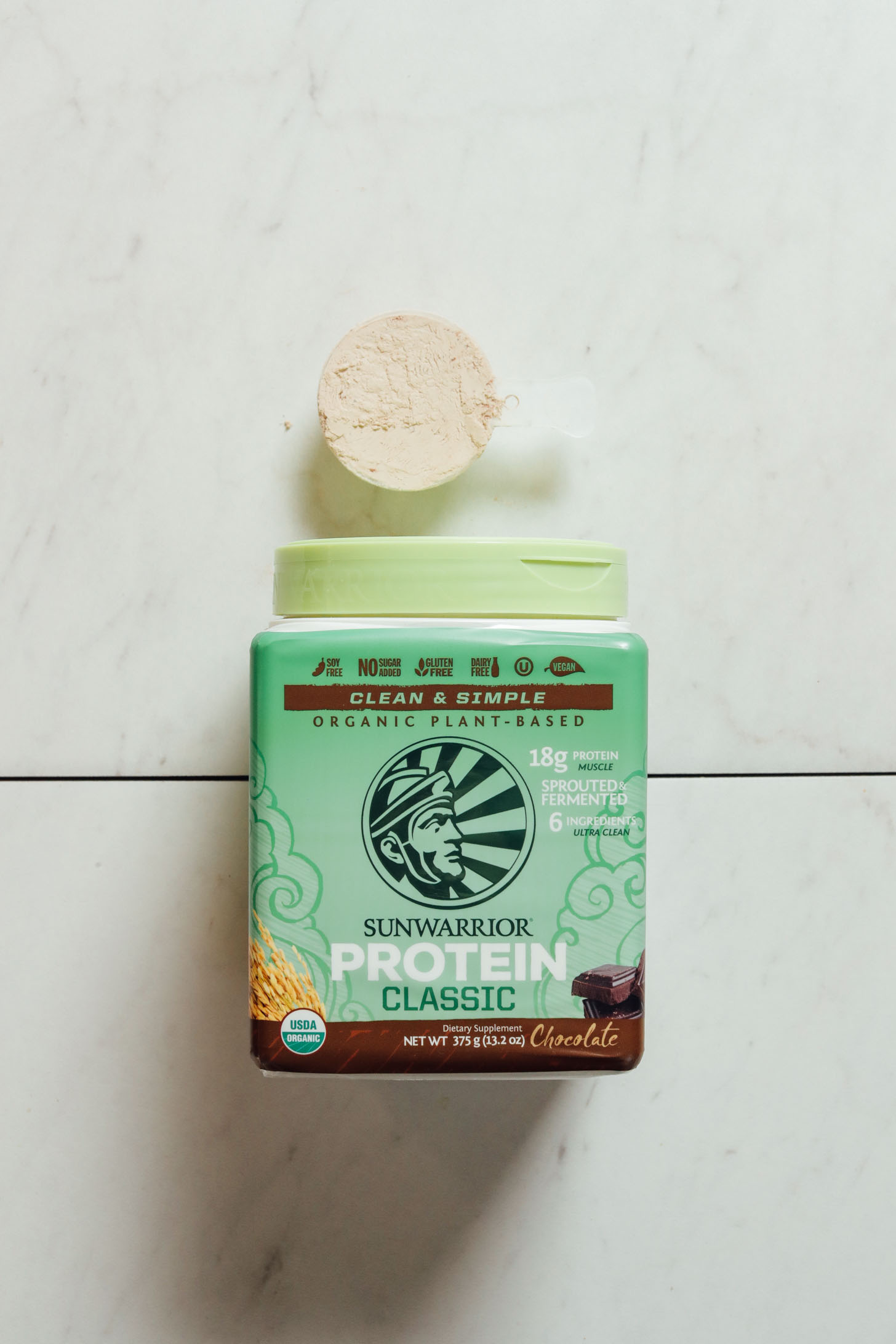
#8: Sunwarrior Organic Classic Chocolate Protein
Texture: 3 – pretty creamy with visually noticeable chunks
Sweetness: 3.25 – artificial sweetness flavor, a bit much
Overall flavor: 3 – noticeable chocolatey-ness, lingering unpleasant aftertaste, slight chalkiness, a little bitterness
How well it blended with non-dairy milk: 4 – some noticeable chunks, but overall quite creamy
How well it tastes/blends with smoothies: 2.5 – Flavor is better blended in a smoothie than shaken. But still bitter and a subtle cardboard flavor. Chocolate flavor is not prominent, but artificial sweetness is. And it somehow remains a little grainy after blending.
Protein base: Organic brown rice protein
Protein / serving: 18 g
Approximate cost per serving: $1.20
Type of sweetener(s): Organic Stevia extract
Additives: Organic vanilla flavor, Organic guar gum
Quality of ingredients: Organic
Other perks: Ancient sea salt
Overall score: 15.75/25
Overall impressions: Pleasant chocolate flavor, but followed by too much sweetness and an unpleasant aftertaste. It’s a little too chalky and overall not enjoyable.
Would we repurchase? No
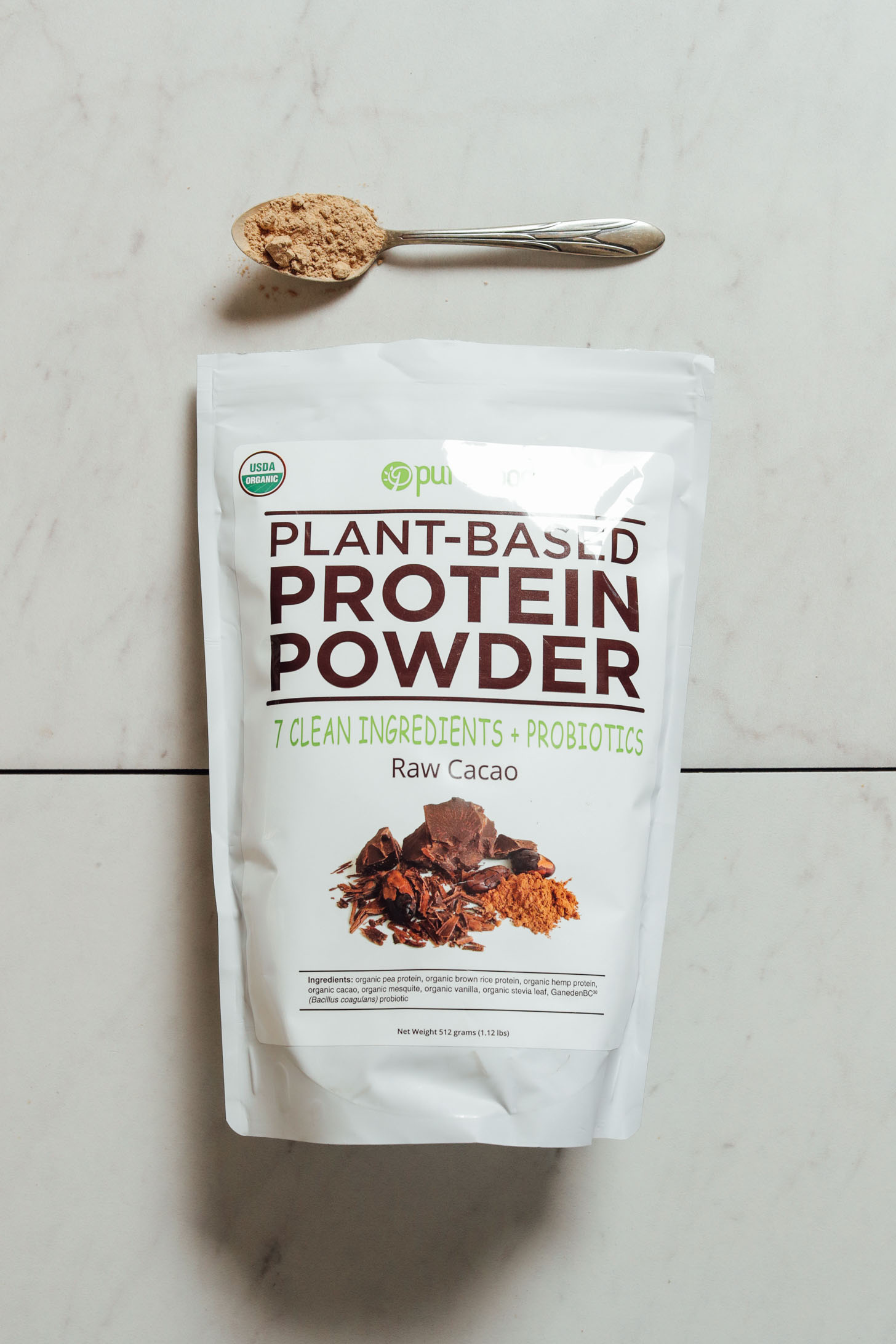
#9: Pure Food Protein Powder – Raw Cacao
Texture: 2 – slightly creamy, but mostly chalky and chunky
Sweetness: 2 – hardly detectable
Overall flavor: 1.5 – tastes bitter, chalky, chocolate flavor is not detectable, leaves an unpleasant aftertaste.
How well it blended with non-dairy milk: 2 – left some chunks, slightly chalky
How well it tastes/blends with smoothies: 3 – The initial taste is pleasant, however it quickly turns to a bitter and almost sour flavor. The texture is also a little grainy despite blending. Not too sweet though, even with banana.
Protein base: Organic pea protein, Organic brown rice protein, Organic hemp protein
Protein / serving: 20 g (2 scoops)
Approximate cost per serving: $2.50
Type of sweetener(s): Organic Stevia leaf
Additives: None
Quality of ingredients: Organic
Other perks: Organic cacao, Organic mesquite, Organic vanilla, Probiotic added (Bacillus coagulans)
Overall score: 10.5/25
Overall impressions: Simple and impressive ingredients, but not enough to counteract flavor and texture issues. It works better with something like banana that sweetens it up / masks the flavor. Still, overall unpleasant, slightly bitter flavor and chalky texture.
Would we repurchase? No
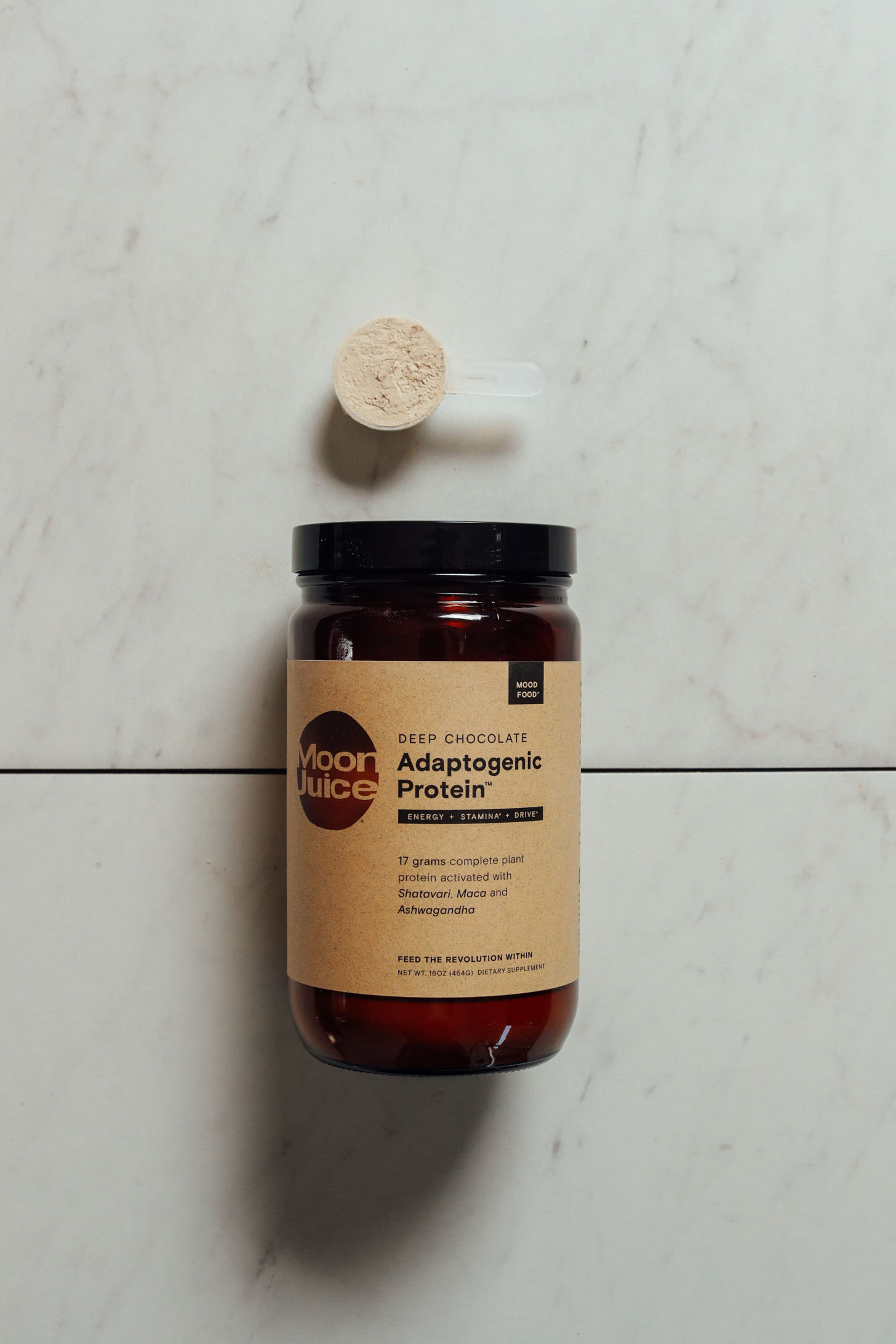
#10: Moon Juice Deep Chocolate Adaptogenic Protein
Texture: 1.5 – didn’t mix well; remained chalky and chunky
Sweetness: 1.5 – hardly sweet at all (which could be desirable if you’re blending with sweeter ingredients)
Overall flavor: 1 – barely palatable, virtually no chocolate flavor, leaves a bad aftertaste, and tastes like sand
How well it blended with non-dairy milk: 1.5 – not well at all
How well it tastes/blends with smoothies: 2 – Has a funky smell and cardboard and mushroom flavors; even when blended has some powdery-ness, but overall, use in a smoothie was way better than just shaken with dairy-free milk.
Protein base: Organic brown rice protein
Protein / serving: 17 g
Approximate cost per serving: $3.67
Type of sweetener(s): Organic Stevia extract
Additives: None
Quality of ingredients: Organic
Other perks: Organic maca root extract, Organic cacao powder, Organic shatavari root powder, Organic ashwagandha root and leaf extract, Organic cinnamon powder
Overall score: 7.5/25
Overall impressions: Maybe the worst protein we have ever tasted. It doesn’t have any pleasant qualities on its own and is significantly more expensive than most protein powders.
Would we repurchase? No
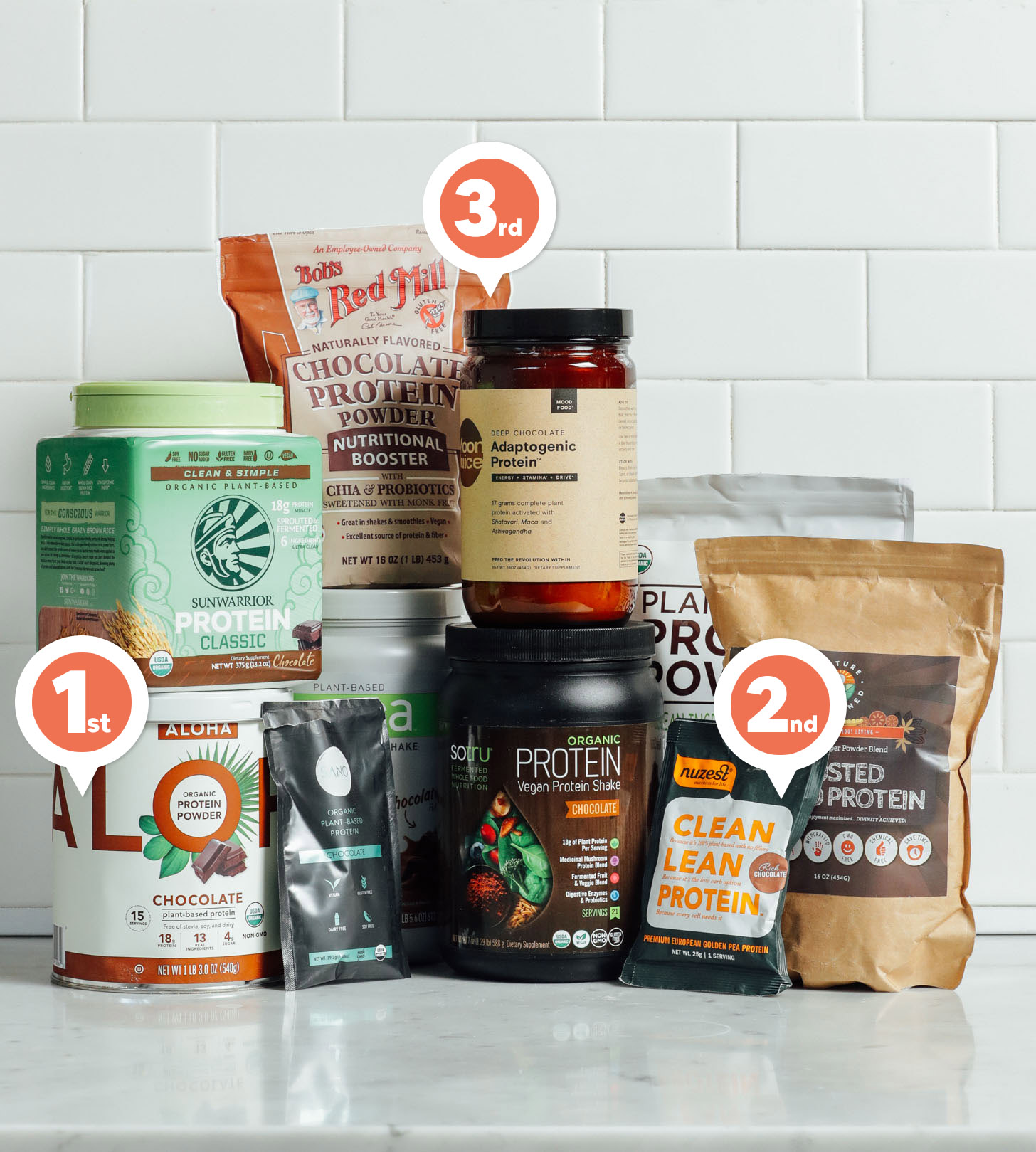
Results //
First place: Aloha Organic Chocolate Protein Powder
Second place: Nuzest Clean Lean Protein – Rich Chocolate
Third place: Bob’s Red Mill Chocolate Protein Powder
Fourth place: SoTru Organic Vegan Protein Shake – Chocolate
Fifth place: Nature Sustained Boosted Choco Protein
Sixth place: Vega Essentials Shake – Chocolate
Seventh place: SANO Organic Plant-Based Protein – Chocolate
Eighth place: Sunwarrior Organic Classic Chocolate Protein
Ninth place: Pure Food Protein Powder – Raw Cacao
Tenth place: Moon Juice Deep Chocolate Adaptogenic Protein
Conclusion //
We tried to be extremely honest in this review, which is why it seems like a lot of the feedback was critical or negative. That’s because we honestly didn’t like many of the protein powders we tried.
But the standouts are definitely the top 3 (above), with numbers 4 and 5 being quite tasty, too.
*Despite Minimalist Baker having had a working relationship with Bob’s Red Mill in the past (which has since been discontinued), our relationship with them had nothing to do with this review. We had no communication with them about it. This post is entirely unsponsored.
*This post contains affiliate links. In the case that you would purchase something using our link, we receive a small commission from Amazon which helps support our work here.


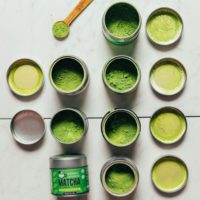
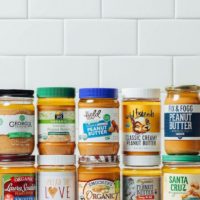



Rusty Johnsone says
Check one of the latest reviews Sept 2020 on Amazon for Nuzest as noted below.
2.0 out of 5 stars Must have changed recipe – terrible!
Reviewed in the United States on September 17, 2020
Verified Purchase
I had been using Nuzest protein for years. I tried dozens of other protein powders on the market and Nuzest was by far the best in terms of all around quality, ingredients, and flavor. I just purchased a new tub of the chocolate 2 weeks ago and made my usual protein shake with it. After one sip I thought maybe the fruit I was using was rotten. Unfortunately, after experimenting multiple times, I realized it was the protein that was producing the awful flavor.
I thought only the packaging was new but they must have changed the recipe or ingredients as well. The flavor of this protein used to be so smooth and pure -nothing trace of anything artificial. Now the flavor leaves you with this terrible almost sour after taste in addition to an intense artificial sweetener aftertaste. I can stomach a lot but this was terrible.
I chucked out the entire tub and unfortunately wont be buying from this company anymore. I am truly so disappointed that I will have to find a new protein powder. Go back to your old recipe please Nuzest!
One person found this helpful
Amelia says
This is a great review! My favorite protein powder is Orgain chocolate. Perfect for smoothies and plant based :)
Thanks for sharing, Amelia!
Jess says
Thank you thank you for this review! I’ve been scared to try vegan protein powders after once trying a horrible sample at Whole Foods. I went with The Nuzest (sample size) and immediately after trying it came back to order a full size. It’s so good!! I’ll have to try your #1 pick next.
Thanks again!
Thanks, Jess!
Chris says
MyProtein has excellent prices on clean pea protein, brown rice protein, and a blend of each, in chocolate and vanilla. Tastes pretty good (especially the chocolate, vanilla can be chalky unless mixed with some other flavors) but the price can’t be beat!
One of the things that skyrocketed in price when my wife and I went vegan a few months ago was the cost of protein powder. We both lift and thus go through a ton of the stuff. Whey protein is cheaper than dirt, but these fancy vegan blends cost an arm and a leg. Can’t be dropping $50/week on protein alone. Then I found MyProtein and I got 13 total pounds for $55 on a sale. Can’t beat that and the ingredients are straight up protein.
We generally use this brand of protein for morning oats, but we still buy the fancy stuff from Whole Foods for the occasion straight-up protein shake when we want a bit more flavor.
Edlyn says
Have you tried Arbonne’s protein powders? They are my favorite. I’d be curious to see where they fall on this scale.
We haven’t! But thanks for the recommendation!
JD says
This is so great, thank you! I highly recommend KOS protein powder as well, it comes in chocolate and vanilla and is all plant based – They also have pantry products that are organic and plant based supplements to add to recipes!
Good to know! Thanks for sharing, JD.
Andrea says
Thanks for taking the time to perform these unbiased/not sponsored reviews on vegan protein powders. After reading your previous vanilla protein powder review, I went out and bought the Bob’s Red Mill, a brand I otherwise would’ve overlooked completely when it comes to protein powder. I enjoyed it. Since then I’ve discovered Vivo Life vegan protein powder and it’s my new all time favorite! Have you heard of/tested this brand? They have cleanly sourced ingredients and the highest vegan protein content per serving (25 grams) I’ve come across for the calories. I also appreciate the fact that the company doesn’t use a plastic tub to package their products, but rather a resealable bag.
Hi Andrea, we aren’t familiar with that brand. Thanks for sharing!
Mason says
Thank you! These lists have been so helpful in hunting down my favorite vegan protein! You’ve done it again, Dana!
Thanks, Mason!
Emily says
Thanks for taking one for the team and trying all these for us :) I appreciate your honest opinions. Very interesting and helpful! Thank you !
PS my current fave protein powder is Orgain (both the vanilla and the chocolate). Give them a try when you get the taste of all those others out of your mouth LOL
Thanks for sharing, Emily!
Ashley says
I love Orgain too! I’m curious why this didn’t make your list
Hi Ashley, we excluded it because it contains erythritol – an artificial sweetener.
Kelli says
Can you tell me what you know about Garden of Life brand? I’m just curious why this wasn’t tested. Is it because of the heavy metals?
Hi there, we did not include it because it contains erythritol, which is a sugar alcohol and may cause digestive upset.
Kelli Mans says
Thanks Dana! I purchased the Aloha brand that you recommend and we love it.
Jes says
You should try Tropeka. The Boost is a chocolate/caramel protein, delicious.
I haven’t tried their straight chocolate, but the salted caramel is amazing with almond milk an a frozen banana (I don’t, however, rate their vanilla).
I actually do enjoy Tropeaka’s vanilla flavor – great ingredients! However, for now it seems it’s only available in Australia and the shipping costs were high. So I tried to include only protein powders that were accessible on Amazon.
Rebecca says
Have you ever tried Orgain protein powders? They are the tastiest vegan protein powders I’ve ever had. (Peanut butter is my fave!) I was wondering why you hadn’t reviewed them or if you knew of any adverse effects.
We did test the Vanilla Orgain! You can see that in our vanilla protein powder review. We didn’t test the chocolate, however, because erythritol was an ingredient and from a nutrition/digestion standpoint it can be a problem for some.
Mariana says
Thank for your review! I was wondering if you considered Orgain for this review as it seems pretty popular.
Does anyone know how it compares to the top choices here? Thanks!
We did test the Vanilla Orgain! You can see that in our vanilla protein powder review. We didn’t test the chocolate, however, because erythritol was an ingredient and from a nutrition/digestion standpoint it can be a problem for some.
lena dolter says
ALOHA is my FAVORITE!! happy to see it made FIRST PLACE!! I love this powder for a lot of reasons, one of them is that it blends so well EVEN WITHOUT A BLENDER!! so it travels well.
Right? Yay! So glad you like it, too!
Mattheus says
I’m curious why Orgain chocolate fudge powder didn’t make the cut?
We did test the Vanilla Orgain! You can see that in our vanilla protein powder review. We didn’t test the chocolate, however, because erythritol was an ingredient and from a nutrition/digestion standpoint it can be a problem for some.
Aryn B Oldham says
Have you tried Ora brand protein? I just started using it and it’s awesome!
Glad you like it! We considered it for the review but ultimately didn’t order!
Natalie says
I second Aryn, the co-owners of Ora Organica are regulars at the coffeeshop I work at & they are extremely lovely people who make really excellent supplement products! I hope you check them out, their chocolate protein powder is the only one I’ve ever liked!
Val says
Is there a negative reason you did not select it?
Hi Val, though the ingredients looked pretty impressive, it was similar to another brand, but contained inulin. Since inulin can contribute to digestive complaints for some people, we opted for the other brand.
Abigail Simon says
Hi- I am really baffled by your Moon Juice review— I have used it and found it blended incredibly smoothly, tasted delicious and had the added bonus of zero sick-sweet-chalky notes. Is it possible you got an old/bad/otherwise faulty jar? I find this stuff amazing
To us, it had the most off-putting flavor and didn’t register as chocolate (on its own) at all. But I’m so glad you like it! The ingredient list IS impressive.
Lindsey says
This is so helpful! I was reading the reviews you did on the vanilla ones the other day and was wishing you had a review for chocolate ones, and then I got an email about this! ? Have you tried any of the chocolate or salted caramel flavored protein powders from Tropeaka? I’ve been really curious about them!
I have! Their vanilla is great. Glad you like their stuff, too!
Erin Bliss says
Something I didn’t see mentioned that I think is extremely important: these products are NOT regulated by the FDA.
This means that their listed ingredients are not necessarily what is actually in the package. My husband, a scientist, tested a brand I won’t name for obvious reasons, and discovered that the major ingredient this brand said was included in their product was not detected AT ALL. Their celebrity fitness “expert” touted the specific ingredient my husband was looking for as its prime ingredient and it just wasn’t there. My husband ordered several packages from several different retailers so he would get a random sampling of the product. All the packages were tested.
I find that lack of oversight on these products frightening.
You could also go to Dr. Oz’s web page and look up similar testing his show did on protein powders to see if your brand was tested for accuracy of ingredients. I know Dr. Oz has lost a lot of credibility because he appears to have sold out to junk science, but this was one of the last studies his show did that was actually right on the money!
Hi Erin, thank you for sharing your experience and information. Our understanding is that manufacturers are “prohibited [by the FDA] from marketing products that are adulterated or misbranded.” We understand that there may be brands that are not in compliance and that is unfortunate. We did our best to try to select brands with integrity and high-quality ingredients.
Maria S Mead says
Thanks for this. I make my own with cacao, the protien powder of my choice (I use a blend) and a few drops of stevia (occasionally maple syrup if I am splurging). I have a smoothie with assorted frozen fruits and this almost daily and it is delicious!
Smart!
Jenny says
My new favorite is Epic Sprout Living Chocolate Maca. It’s available on Amazon too. I alternate between that and Aloha usually.
Lovely! Thanks for sharing!
Rachel Chapman says
You should check out Zenberry!
Thanks for sharing!
LMM says
This is perfect timing! I have been searching for a new vegan protein powder. It’s SO hard, either the taste is absolutely horrible or it contains things like maca (I realized I am SUPER intolerant to that) or chicory/inulin which in larger quantities does not make me feel good at all. I am going to try one of these, I usually prefer vanilla because I like to mix with fruit but my go to lately has been hard to find. Growing Naturals Vanilla Blast (it’s super awesome with Mango) It’s great to have a good chocolate powder on hand too to mix things up a bit.
I also try to limit inulin (for digestive health)! Thanks for sharing your tips!
XOCHITL MAIMAN says
My fav chocolate protein powder is Growing Naturals, Pea or Rice. Seems to be back in stock everywhere now, including their website.
LMM says
Good to know, I haven’t had a smoothie in months! I haven’t tried the chocolate one, just the vanilla but it is tasty. If you mix the pea and the rice together it’s healthier, but the rice one seems harder to find for some reason.
Ellen says
Thanks for the review Dana!
Has anyone had the PB2 (powdered peanut butter) in addition to any of the above? That’s been my only intro to chocolate protein powder so I’d love to know how PB2 stacks up against the ones reviewed in this post.
I do tend to keep a powdered PB on hand for adding flavor to smoothies as well!
Erin says
Thanks for the detailed breakdown. I can’t stand the aftertaste of stevia, so it was nice to see you specify the type of sweetener used in each powder!
Thanks for sharing, Erin!
Jen says
If you consume protein powder and find yourself with joint pain, check the ingredients. In my experience, pea protein causes outrageous joint pain (for me, it’s concentrated in my knuckles) within a half hour of consuming it. I thought I must be unique in experiencing this, but discovered a lot of people are having the same issue. I avoid anything with pea protein like the plague now! Related, I was a huge GoMacro MacroBar fan until they recently changed their ingredients to include pea protein.
Thanks for sharing your experience, Jen!
Régine says
Thanks for the review, Dana. I do love your blog. Another important criterium for me is plastic/not plastic container.
Also, since Bob Red Mill is non organic, I would imagine their cornstarch is GMO – a no no for me.
Would you have an idea about getting enough protein in a more natural way? (I do eat lots of beans).
Lentils are my go-to high protein option. I can do organic, non-GMO soy in limited amounts. Otherwise nuts and seeds! I’m sharing my go-to protein powder-free “protein shake” soon!
Régine says
Wonderful. Thank you so much Dana!
Dee says
Wow, thank you for sharing that. I did not know that and wouldn’t have even thought that was my issue. Thanks!
Marianne says
Just an FYI ( which was a real eye opener for me) several of the brands in your post actually have been called out for having TOXIC levels of leads and other metals .. read up on them and use with caution
Hi Marianne, thanks for sharing the concern! We are familiar with some of the testing out there on protein powders which is why we mention “we prefer to have most of our meals closer to their “from the farm” roots…[but] we find protein powders to be a great option when traveling, on-the-go, needing something simple, or when the fridge is low.” Unfortunately not all of the brands out there have been tested so it is hard to know whether this is a problem with protein powders in general or specific brands. Thanks again!
Lacey says
This was such an interesting read. I also went back and read your vanilla protein powder review. I’m really intrigued by the idea of being able to use a mason jar to shake up the powder and non-dairy milk. I hope you do more of these reviews, especially for chai flavored (my favorite) powders!
So glad to hear it! Chai is upcoming :)